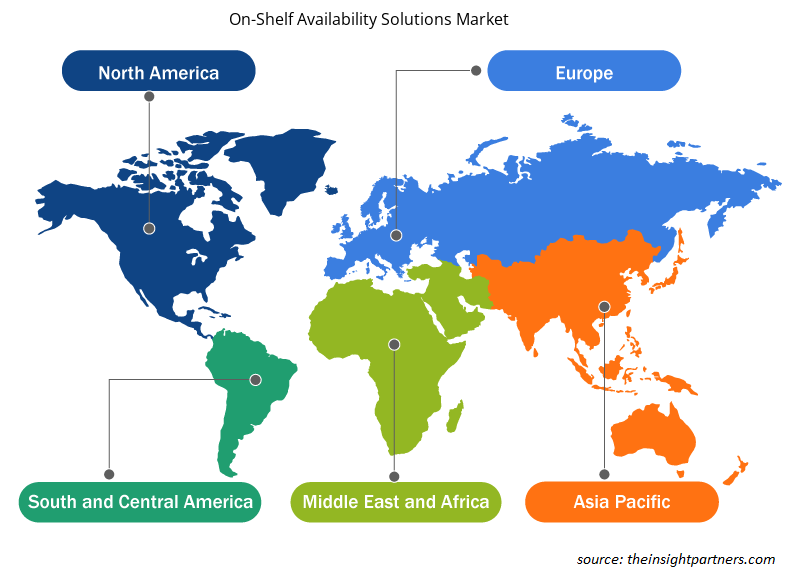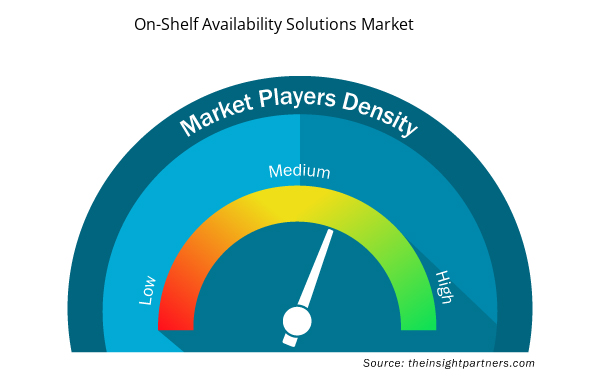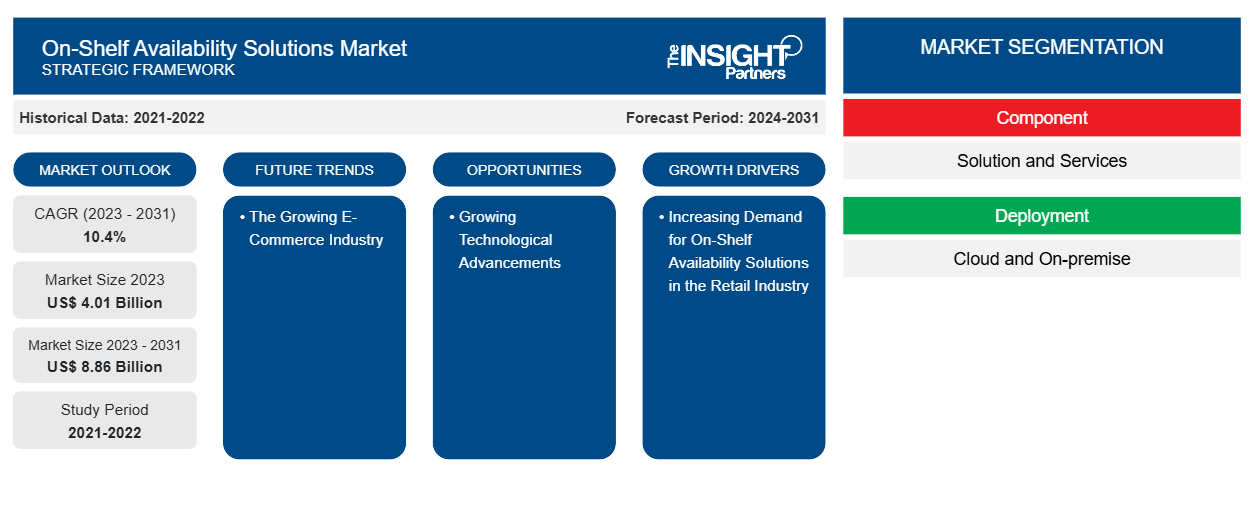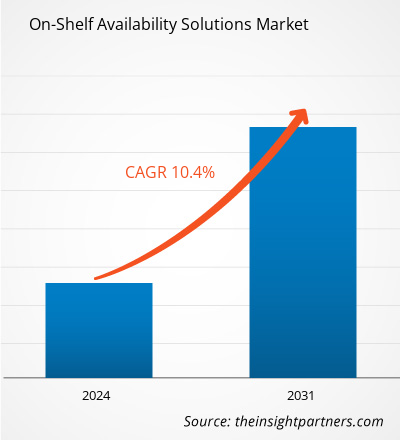Der Markt für Regalverfügbarkeitslösungen soll von 4,01 Milliarden US-Dollar im Jahr 2023 auf 8,86 Milliarden US-Dollar im Jahr 2031 anwachsen. Der Markt wird voraussichtlich zwischen 2023 und 2031 eine durchschnittliche jährliche Wachstumsrate von 10,4 % verzeichnen. Die wachsende E-Commerce-Branche wird voraussichtlich ein wichtiger Markttrend für Regalverfügbarkeitslösungen bleiben.
Marktanalyse für On-Shelf-Verfügbarkeitslösungen
Die wachsende Zahl von Einzelhandelsgeschäften weltweit steigert die Nachfrage nach Regalverfügbarkeitslösungen im Einzelhandel, was einer der Hauptfaktoren ist, die das Wachstum des Marktes antreiben. Darüber hinaus treiben die wachsende Nachfrage nach Omnichannel- Lösungen und der zunehmende Fokus auf das Kundenerlebnis das Wachstum des Marktes voran. Darüber hinaus schafft die zunehmende Integration fortschrittlicher Technologien wie KI, ML, Computer Vision und andere eine Chance für das Wachstum des Marktes für Regalverfügbarkeitslösungen in den kommenden Jahren.
Marktübersicht für On-Shelf-Verfügbarkeitslösungen
Unter Regalverfügbarkeit versteht man die Anwesenheit eines Produkts in den Regalen eines Geschäfts, wenn ein Kunde kommt, um es zu kaufen. Die Regalverfügbarkeit garantiert, dass Kunden das gewünschte Produkt einfach und problemlos kaufen können. Für den Einzelhändler bedeutet sie zufriedene Kunden sowie höhere Umsätze aus Produktverkäufen. Auch Hersteller profitieren von der Regalverfügbarkeit, da sie den Verkauf ihrer Waren garantiert und nützliche Informationen für die Bestandskontrolle bietet. Daher ist die Regalverfügbarkeit im Einzelhandel ein entscheidender Faktor, der effektiv überwacht und aufrechterhalten werden muss.
Passen Sie diesen Bericht Ihren Anforderungen an
Sie erhalten kostenlose Anpassungen an jedem Bericht, einschließlich Teilen dieses Berichts oder einer Analyse auf Länderebene, eines Excel-Datenpakets sowie tolle Angebote und Rabatte für Start-ups und Universitäten.
- Holen Sie sich die wichtigsten Markttrends aus diesem Bericht.Dieses KOSTENLOSE Beispiel umfasst eine Datenanalyse von Markttrends bis hin zu Schätzungen und Prognosen.
Markttreiber und Chancen für On-Shelf-Verfügbarkeitslösungen
Steigende Nachfrage nach Regalverfügbarkeitslösungen im Einzelhandel
Die Grundlagen des Ladenbetriebs sind für viele Einzelhändler weiterhin eine Herausforderung, häufig, weil sie die vorhandenen Daten nicht interpretieren können oder keinen Zugriff auf die erforderlichen Informationen haben, um Verbesserungen vorzunehmen. Um dieses Problem zu lösen, setzen Einzelhändler auf Regalverfügbarkeitslösungen. Diese Lösung kann Einzelhändlern helfen, die Kundenzufriedenheit zu steigern und den Umsatz durch den Verkauf des Produkts zu erhöhen. Darüber hinaus hilft sie Einzelhändlern, den Ruf ihrer Marke zu verbessern und eine positivere Unternehmenskultur zu fördern. Alle oben genannten Faktoren erhöhen also die Nachfrage nach Regalverfügbarkeitslösungen im Einzelhandel und treiben das Wachstum des Marktes voran.
Wachsender technologischer Fortschritt
Die manuelle Regalverwaltung erfordert einen hohen Personalaufwand und wird meist in einer festgelegten Häufigkeit durchgeführt. Um dieses Problem zu lösen, arbeiten verschiedene Marktteilnehmer kontinuierlich an der Integration fortschrittlicher Technologien wie KI , Computer Vision und anderen. Die Integration der Technologien kann automatisch dazu beitragen, OOS-Artikel, falsche Platzierungen und andere Probleme zu erkennen, indem Regalartikel mithilfe von Algorithmen wie Preisschilderkennung, Produkterkennung, OOS-Erkennung, Aktivitätserkennung und optischer Zeichenerkennung (OCR) identifiziert, klassifiziert und inventarisiert werden. Daher können solche technologischen Fortschritte im Prognosezeitraum eine Chance für Marktwachstum schaffen.
Marktbericht zu On-Shelf-Verfügbarkeitslösungen – Segmentierungsanalyse
Wichtige Segmente, die zur Ableitung der Marktanalyse für Lösungen zur Regalverfügbarkeit beigetragen haben, sind Komponente, Bereitstellung und Endbenutzer.
- Basierend auf den Komponenten ist der Markt in Lösungen und Dienstleistungen unterteilt. Das Lösungssegment hatte im Jahr 2023 einen größeren Marktanteil.
- Nach Bereitstellung ist der Markt in Cloud und On-Premise segmentiert. Das Cloud-Segment hatte im Jahr 2023 den größten Marktanteil.
- Nach Endverbraucher ist der Markt in CPG-Hersteller, Einzelhändler, Lieferanten und andere segmentiert. Das Segment der CPG-Hersteller hielt im Jahr 2023 den größten Marktanteil.
Marktanteilsanalyse für On-Shelf-Verfügbarkeitslösungen nach geografischer Lage
Der geografische Umfang des Marktberichts zu Lösungen zur Regalverfügbarkeit ist hauptsächlich in fünf Regionen unterteilt: Nordamerika, Asien-Pazifik, Europa, Naher Osten und Afrika sowie Südamerika/Süd- und Mittelamerika.
In Bezug auf den Umsatz hatte Nordamerika den größten Marktanteil bei Lösungen zur Regalverfügbarkeit. Der Markt in dieser Region ist in die USA, Kanada und Mexiko unterteilt. Die Region erlebt einen enormen Anstieg ihres E-Commerce-Sektors, der einer der Hauptfaktoren für das Wachstum des Marktes ist. Darüber hinaus verfügt die Region über hoch entwickelte Einzelhandels- und Lieferkettensektoren, was weiter zur steigenden Nachfrage nach Lösungen zur Regalverfügbarkeit in Nordamerika beiträgt.
Regionale Einblicke in den Markt für On-Shelf-Verfügbarkeitslösungen
Die regionalen Trends und Faktoren, die den Markt für On-Shelf-Verfügbarkeitslösungen während des gesamten Prognosezeitraums beeinflussen, wurden von den Analysten von Insight Partners ausführlich erläutert. In diesem Abschnitt werden auch die Marktsegmente und die Geografie von On-Shelf-Verfügbarkeitslösungen in Nordamerika, Europa, im asiatisch-pazifischen Raum, im Nahen Osten und Afrika sowie in Süd- und Mittelamerika erörtert.

- Erhalten Sie regionale Daten zum Markt für On-Shelf-Verfügbarkeitslösungen
Umfang des Marktberichts zu On-Shelf-Verfügbarkeitslösungen
| Berichtsattribut | Details |
|---|---|
| Marktgröße im Jahr 2023 | 4,01 Milliarden US-Dollar |
| Marktgröße bis 2031 | 8,86 Milliarden US-Dollar |
| Globale CAGR (2023 - 2031) | 10,4 % |
| Historische Daten | 2021-2022 |
| Prognosezeitraum | 2024–2031 |
| Abgedeckte Segmente | Nach Komponente
|
| Abgedeckte Regionen und Länder | Nordamerika
|
| Marktführer und wichtige Unternehmensprofile |
|
Dichte der Marktteilnehmer für Lösungen zur Regalverfügbarkeit: Die Auswirkungen auf die Geschäftsdynamik verstehen
Der Markt für On-Shelf-Availability-Lösungen wächst rasant, angetrieben von der steigenden Nachfrage der Endnutzer aufgrund von Faktoren wie sich entwickelnden Verbraucherpräferenzen, technologischen Fortschritten und einem größeren Bewusstsein für die Vorteile des Produkts. Mit steigender Nachfrage erweitern Unternehmen ihr Angebot, entwickeln Innovationen, um die Bedürfnisse der Verbraucher zu erfüllen, und nutzen neue Trends, was das Marktwachstum weiter ankurbelt.
Die Marktteilnehmerdichte bezieht sich auf die Verteilung von Firmen oder Unternehmen, die in einem bestimmten Markt oder einer bestimmten Branche tätig sind. Sie gibt an, wie viele Wettbewerber (Marktteilnehmer) in einem bestimmten Marktraum im Verhältnis zu seiner Größe oder seinem gesamten Marktwert präsent sind.
Die wichtigsten Unternehmen auf dem Markt für On-Shelf-Verfügbarkeitslösungen sind:
- Atlas Technology Group
- BeMyEye Holdings Ltd.
- IBM Corporation
- Lösungen für den Einzelhandel
- Einschl.
- SAP SE
Haftungsausschluss : Die oben aufgeführten Unternehmen sind nicht in einer bestimmten Reihenfolge aufgeführt.

- Überblick über die wichtigsten Akteure auf dem Markt für On-Shelf-Verfügbarkeitslösungen
Marktnachrichten und aktuelle Entwicklungen zu Lösungen zur Regalverfügbarkeit
Der Markt für On-Shelf-Availability-Lösungen wird durch die Erfassung qualitativer und quantitativer Daten nach Primär- und Sekundärforschung bewertet, die wichtige Unternehmensveröffentlichungen, Verbandsdaten und Datenbanken umfasst. Im Folgenden finden Sie eine Liste der Entwicklungen auf dem Markt für Sprach- und Sprechstörungen und -strategien:
- Retail Velocity, der Pionier und Branchenführer im Bereich Datenmanagement, Reporting und Analyse von Verbrauchernachfrage und -angebot, hat die Einführung der 10. Generation seiner VELOCITY-Plattform und die Einführung von VELOCITY Essential angekündigt. Dieses neue VELOCITY Pro 10 bietet mehr Leistung, einfacheres Datenmanagement, verbessertes Reporting und zusätzliche Sicherheit, sodass Hersteller von Konsumgütern schneller als je zuvor tiefere, umsetzbare Erkenntnisse gewinnen, intern und mit Einzelhandelspartnern fundiertere, kollaborative Entscheidungen treffen und schnell und effektiv auf sich ändernde Verbrauchernachfrage und Marktbedingungen reagieren können. (Quelle: Retail Velocity, Pressemitteilung, 2022)
- Tredence Inc., ein führendes Unternehmen für Datenwissenschaft und KI-Engineering, gab eine Partnerschaft mit Databricks bekannt, dem führenden Anbieter von Unified Analytics, der von den ursprünglichen Entwicklern von Apache Spark gegründet wurde. Im Rahmen dieser Partnerschaft entwickelten die Unternehmen gemeinsam den On-Shelf Availability Solution (OSA)-Beschleuniger, der Einzelhändlern und Herstellern hilft, Lagerbestände zu beheben, indem er die Datenverarbeitungsfunktionen von Databricks und die Expertise von Tredence im Bereich KI/ML kombiniert. (Quelle: Tredence Inc, Pressemitteilung, 2021)
Marktbericht zu Lösungen zur Regalverfügbarkeit – Abdeckung und Ergebnisse
Der Bericht „Marktgröße und Prognose für On-Shelf-Verfügbarkeitslösungen (2021–2031)“ bietet eine detaillierte Analyse des Marktes, die die folgenden Bereiche abdeckt:
- Marktgröße und Prognose auf globaler, regionaler und Länderebene für alle wichtigen Marktsegmente, die im Rahmen des Projekts abgedeckt sind
- Marktdynamik wie Treiber, Beschränkungen und wichtige Chancen
- Wichtige Zukunftstrends
- Detaillierte PEST/Porters Five Forces- und SWOT-Analyse
- Globale und regionale Marktanalyse mit wichtigen Markttrends, wichtigen Akteuren, Vorschriften und aktuellen Marktentwicklungen
- Branchenlandschaft und Wettbewerbsanalyse, einschließlich Marktkonzentration, Heatmap-Analyse, prominenten Akteuren und aktuellen Entwicklungen
- Detaillierte Firmenprofile
- Historische Analyse (2 Jahre), Basisjahr, Prognose (7 Jahre) mit CAGR
- PEST- und SWOT-Analyse
- Marktgröße Wert/Volumen – Global, Regional, Land
- Branche und Wettbewerbsumfeld
- Excel-Datensatz


- Volumetric Video Market
- Genetic Testing Services Market
- Lyophilization Services for Biopharmaceuticals Market
- EMC Testing Market
- Electronic Health Record Market
- Medical Audiometer Devices Market
- Parking Management Market
- Legal Case Management Software Market
- Vertical Farming Crops Market
- Redistribution Layer Material Market

Report Coverage
Revenue forecast, Company Analysis, Industry landscape, Growth factors, and Trends

Segment Covered
This text is related
to segments covered.

Regional Scope
North America, Europe, Asia Pacific, Middle East & Africa, South & Central America

Country Scope
This text is related
to country scope.
Häufig gestellte Fragen
The global on-shelf availability solutions market is expected to reach US$ 8.86 billion by 2031.
The key players holding majority shares in the global on-shelf availability solutions market are Atlas Technology Group, BeMyEye Holdings Ltd., IBM Corporation, Retail Solutions, Inc., SAP SE, Tech Mahindra Limited, Retail Velocity, Panasonic Corporation, NEOGRID, and Enterra Solutions LLC.
Increasing demand for on-shelf availability solutions in the retail industry are the major factors that propel the global on-shelf availability solutions market.
The global on-shelf availability solutions market was estimated to be US$ 4.01 billion in 2023 and is expected to grow at a CAGR of 10.4% during the forecast period 2023 - 2031.
The growing e-commerce industry is anticipated to play a significant role in the global on-shelf availability solutions market in the coming years.
Trends and growth analysis reports related to Technology, Media and Telecommunications : READ MORE..
The Insight Partners performs research in 4 major stages: Data Collection & Secondary Research, Primary Research, Data Analysis and Data Triangulation & Final Review.
- Data Collection and Secondary Research:
As a market research and consulting firm operating from a decade, we have published and advised several client across the globe. First step for any study will start with an assessment of currently available data and insights from existing reports. Further, historical and current market information is collected from Investor Presentations, Annual Reports, SEC Filings, etc., and other information related to company’s performance and market positioning are gathered from Paid Databases (Factiva, Hoovers, and Reuters) and various other publications available in public domain.
Several associations trade associates, technical forums, institutes, societies and organization are accessed to gain technical as well as market related insights through their publications such as research papers, blogs and press releases related to the studies are referred to get cues about the market. Further, white papers, journals, magazines, and other news articles published in last 3 years are scrutinized and analyzed to understand the current market trends.
- Primary Research:
The primarily interview analysis comprise of data obtained from industry participants interview and answers to survey questions gathered by in-house primary team.
For primary research, interviews are conducted with industry experts/CEOs/Marketing Managers/VPs/Subject Matter Experts from both demand and supply side to get a 360-degree view of the market. The primary team conducts several interviews based on the complexity of the markets to understand the various market trends and dynamics which makes research more credible and precise.
A typical research interview fulfils the following functions:
- Provides first-hand information on the market size, market trends, growth trends, competitive landscape, and outlook
- Validates and strengthens in-house secondary research findings
- Develops the analysis team’s expertise and market understanding
Primary research involves email interactions and telephone interviews for each market, category, segment, and sub-segment across geographies. The participants who typically take part in such a process include, but are not limited to:
- Industry participants: VPs, business development managers, market intelligence managers and national sales managers
- Outside experts: Valuation experts, research analysts and key opinion leaders specializing in the electronics and semiconductor industry.
Below is the breakup of our primary respondents by company, designation, and region:

Once we receive the confirmation from primary research sources or primary respondents, we finalize the base year market estimation and forecast the data as per the macroeconomic and microeconomic factors assessed during data collection.
- Data Analysis:
Once data is validated through both secondary as well as primary respondents, we finalize the market estimations by hypothesis formulation and factor analysis at regional and country level.
- Macro-Economic Factor Analysis:
We analyse macroeconomic indicators such the gross domestic product (GDP), increase in the demand for goods and services across industries, technological advancement, regional economic growth, governmental policies, the influence of COVID-19, PEST analysis, and other aspects. This analysis aids in setting benchmarks for various nations/regions and approximating market splits. Additionally, the general trend of the aforementioned components aid in determining the market's development possibilities.
- Country Level Data:
Various factors that are especially aligned to the country are taken into account to determine the market size for a certain area and country, including the presence of vendors, such as headquarters and offices, the country's GDP, demand patterns, and industry growth. To comprehend the market dynamics for the nation, a number of growth variables, inhibitors, application areas, and current market trends are researched. The aforementioned elements aid in determining the country's overall market's growth potential.
- Company Profile:
The “Table of Contents” is formulated by listing and analyzing more than 25 - 30 companies operating in the market ecosystem across geographies. However, we profile only 10 companies as a standard practice in our syndicate reports. These 10 companies comprise leading, emerging, and regional players. Nonetheless, our analysis is not restricted to the 10 listed companies, we also analyze other companies present in the market to develop a holistic view and understand the prevailing trends. The “Company Profiles” section in the report covers key facts, business description, products & services, financial information, SWOT analysis, and key developments. The financial information presented is extracted from the annual reports and official documents of the publicly listed companies. Upon collecting the information for the sections of respective companies, we verify them via various primary sources and then compile the data in respective company profiles. The company level information helps us in deriving the base number as well as in forecasting the market size.
- Developing Base Number:
Aggregation of sales statistics (2020-2022) and macro-economic factor, and other secondary and primary research insights are utilized to arrive at base number and related market shares for 2022. The data gaps are identified in this step and relevant market data is analyzed, collected from paid primary interviews or databases. On finalizing the base year market size, forecasts are developed on the basis of macro-economic, industry and market growth factors and company level analysis.
- Data Triangulation and Final Review:
The market findings and base year market size calculations are validated from supply as well as demand side. Demand side validations are based on macro-economic factor analysis and benchmarks for respective regions and countries. In case of supply side validations, revenues of major companies are estimated (in case not available) based on industry benchmark, approximate number of employees, product portfolio, and primary interviews revenues are gathered. Further revenue from target product/service segment is assessed to avoid overshooting of market statistics. In case of heavy deviations between supply and demand side values, all thes steps are repeated to achieve synchronization.
We follow an iterative model, wherein we share our research findings with Subject Matter Experts (SME’s) and Key Opinion Leaders (KOLs) until consensus view of the market is not formulated – this model negates any drastic deviation in the opinions of experts. Only validated and universally acceptable research findings are quoted in our reports.
We have important check points that we use to validate our research findings – which we call – data triangulation, where we validate the information, we generate from secondary sources with primary interviews and then we re-validate with our internal data bases and Subject matter experts. This comprehensive model enables us to deliver high quality, reliable data in shortest possible time.


 Holen Sie sich ein kostenloses Muster für diesen Bericht
Holen Sie sich ein kostenloses Muster für diesen Bericht